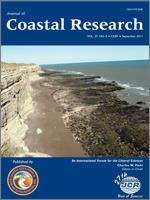School of Atlantic Spadefish (Chaetodipterus faber) along a Southeast Florida Atlantic Coast Reef Tract. The reefs along the southeast Florida coast serve as important foraging and breeding grounds for a great many endemic fish species. One such species is the Atlantic spadefish (Chaetodipterus faber), which are commonly found in the western Atlantic and Caribbean Sea. Known for their distinct ′angelfish-like′ body morphology, Atlantic spadefish display irregular black vertical bands that fade over time, allowing for an individual's approximate age. This species is also an important food web component of the coral reef ecosystem, as they mainly feed on benthic invertebrates and zooplankton, and in return serve as prey items to larger predatory fish such as barracuda (Sphyraena spp.) and reef sharks (Carcharhinus spp.). (Photograph by Christopher Makowski, Department of Geosciences, Florida Atlantic University, Boca Raton, FL 33431, USA).

Alveolar or Honeycomb Weathering of Coastal Cliffs at Bondi Beach, Sydney, Australia. Alveolar or honeycomb weathering of Hawkesbury Sandstone (Triassic Age, 190-225 million years), exposed along Bondi Beach coastal walk is a fantastic structural feature where one can stop to admire and enjoy nature's creations. Alveolar or honeycomb weathering, also known as fretting, cavernous weathering, stone lattice, stone lace or miniature tafoni weathering, is a type of salt weathering common on coastal and semi-arid granites, sandstones and limestones (Mustoe, 1982). This photograph shows a close-up view of alveolar or honeycomb weathering of Hawkesbury Sandstone exposed along Bondi Beach Coastal Walk in Sydney, Australia. Also note the interconnected solution caverns throughout the sandstone. (Photograph by P.T. Hanamgond, Department of Geology, G.S. Science Degree College, Tilakwadi, Belgaum 590 006, India, on 22 April 2008, during his visit to Australia for the ICS 2007. Dr. Hanamgond is thankful to the Coastal Education & Research Foundation (CERF) and the Abheraj Baldota Foundation for their financial support to attend the ICS.)•Mustoe, G.E., 1982. The origin of honeycomb weathering. Geological Society of America Bulletin, 93,108-115.

Hillsboro Inlet, Southeast Florida Atlantic Coast. This is one of the few natural inlets in southeast Florida, being an outlet for the Hillsboro River. The inlet was dredged to accommodate deeper draft vessels and is maintained by dredging from the sand trap on the north (updrift) side of the entrance shoreward of the weir jetty designed by Per Bruun, who took advantage of the bedrock outcrop of the Anastasia Formation. Sand is pumped by the floating dredge to the south (downdrift) side of the inlet to help maintain beach width and support littoral transport. This inlet was the first inlet in Florida to bypass 100% of the littoral drift by mechanical means. (Photograph by Charlie Finkl, Department of Geosciences, Florida Atlantic University, Boca Raton, FL 33431, USA).






